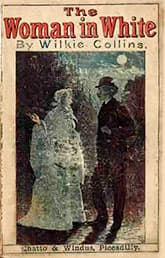The Woman in White
Critique • Quotes • At the movies
 1889 yellowback edition
1889 yellowback editionFirst publication
1859–1860, serialized in magazines All the Year Round and Harper's Weekly
First book publication
1860
Literary form
Novel
Genre
Literary, mystery
Writing language
English
Author's country
England
Length
Approx. 247,000 words
The thrilling start of it all
In the argument about whether The Woman in White or The Moonstone is Wilkie Collins's first great mystery novel—and thus arguably the first great mystery novel ever—a compromise is generally found.
The Moonstone is credited as a seminal mystery and detective novel, while the earlier Woman in White—which also features a mystery-solving sleuth (albeit an amateur)—is honoured as one of the first great sensation novels, or thrillers, as we call them now.
This makes sense, as The Woman in White is one of the most heavily plotted novels you're ever likely to read. And it is sensational. There's the ghostly appearance of a mysterious woman, a secret society, a fortune to be inherited, an illegitimate birth, a flaming death, a fake marriage, switched identities, foreign agents, paranoia, bribery, blackmail, conspiracies—the twists and revelations keep coming.
To tell the truth, as exciting and enticing as The Woman in White is, the endless plot contortions can become wearisome, especially toward the end.
What saves it though is the characters. These are not just stick figures going through their actions as in many a modern thriller. They're well fleshed-out characters whose fates we actually care about, whether we like them or not.
Revealing depths
Collins is quite deliberate in making sure his plots and characters work together. In a preface to the book's second edition, he writes:
I have always held the old-fashioned opinion that the primary object of a work of fiction should be to tell a story; and I have never believed that the novelist who properly performed this first condition of his art, was in danger, on that account, of neglecting the delineation of character.... It may be possible, in novel-writing, to present characters successfully without telling a story; but it is not possible to tell a story successfully without presenting characters....
This may be his answer to critics who charge his work is melodrama, appealing overly to the emotions at the expense of serious characterization. His figures' personalities come from how they behave in the narrative. They may not be as quickly drawn as, say, most of Charles Dickens's memorable fictional figures, but the best of them come through the fire revealing depths that may have been hidden at first.
In a novel full of colourful heroes, villains and figures of mystery, one of the most interesting characters is the initially nondescript older, spinster sister Marian who selflessly comes to the aid of the central romantic couple.
Collins is especially brilliant at dialogue in The Woman in White. Each speech is delivered in exactly the right voice—and contributes to the narrative.
I don't know if any writer before this has so creatively and successfully used multiple narrators. Nothing seems forced. Each narrator is introduced naturally. Each has a good reason for presenting part of the account from his or her perspective.
It's appreciated that Collins, like other old-time authors, feels compelled to conclude all his tale's many threads. The modernist (or is it post-modernist?) trend of ending a story suddenly with loose ends hanging all over the place can be frustrating.
New and old directions
However, Collins may be going too far with all the extended revelations and plot points at the end of this novel about a secret society's activities and all the details of a certain character's conspiring. They seem to take the novel in new directions very late in the story—and away from the personal concerns of the characters we've grown attached to. It comes across as the author trying in the conclusion to give greater gravity to what he fears might be perceived as a superficial melodrama. Unnecessarily.
I also object to The Prince and the Pauper syndrome that runs through so much Victorian literature. Why is it so important to reveal that a hero who was resigned to being an honest and happy commoner is really—what a wonderful surprise!—an aristocrat! The rightful inheritor of great wealth! Strangely, it seems authors concerned with reform and social justice are most susceptible to the appeal of this twist. As if a character's victory in finding love, truth and justice were not enough, but they must also be discovered to have blue blood.
But that's a complaint that applies to only a small part of The Woman in White and probably has more to do with writers having to please the readers of their time. Just like those long-standing and equally unrealistic literary shibboleths of evil-doers being vanquished, crime never paying, and love overcoming all.
For Collins, as for Dickens and others, it's all about winning the engagement of readers with their characters. And The Woman in White does that in spades.
— Eric
Critique • Quotes • At the movies

